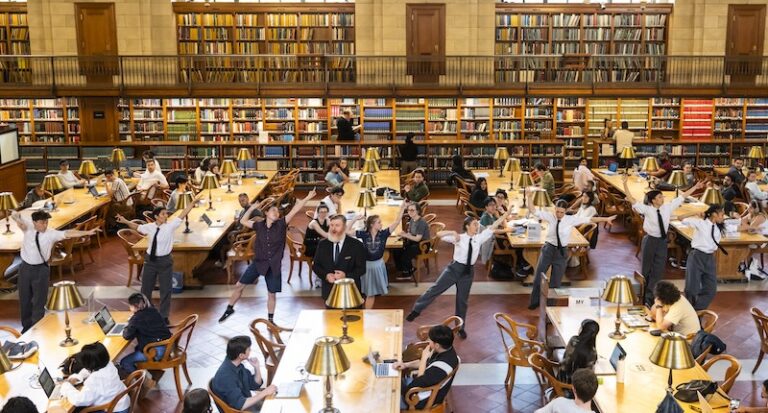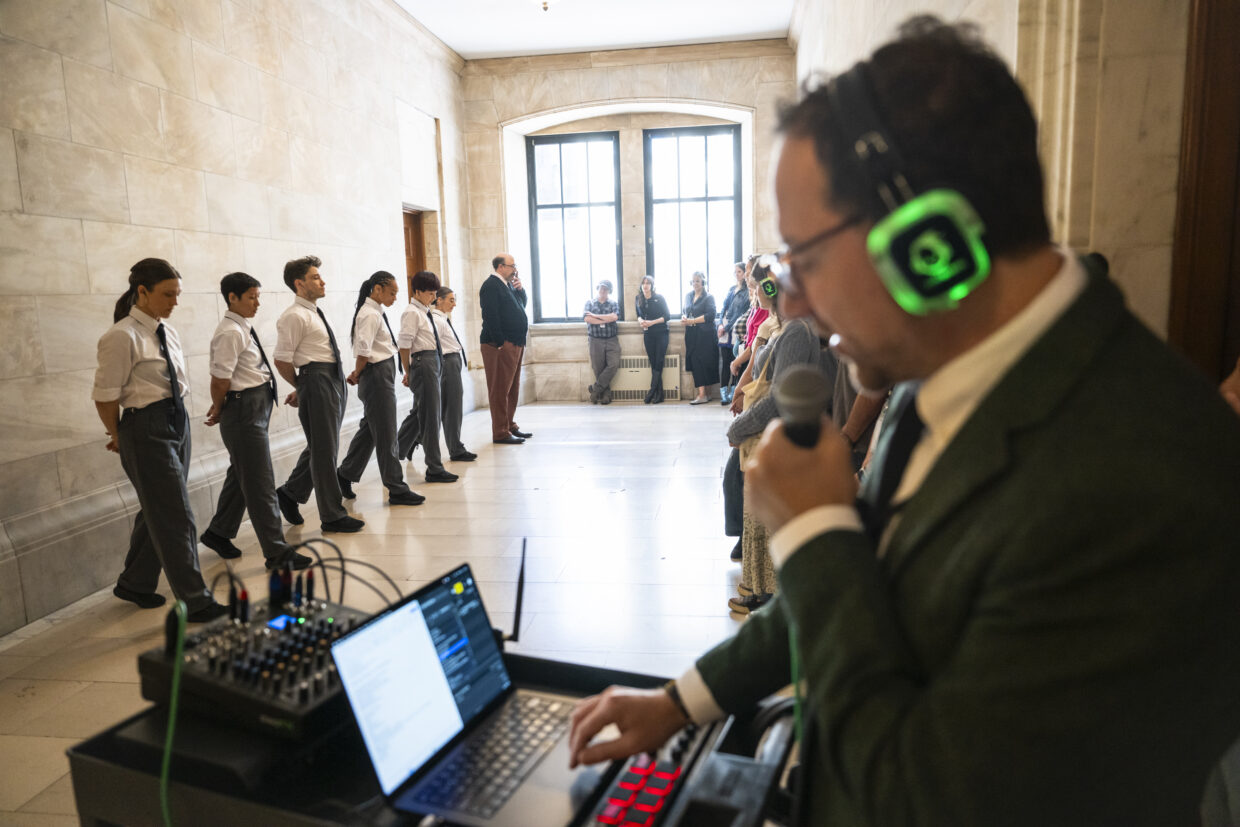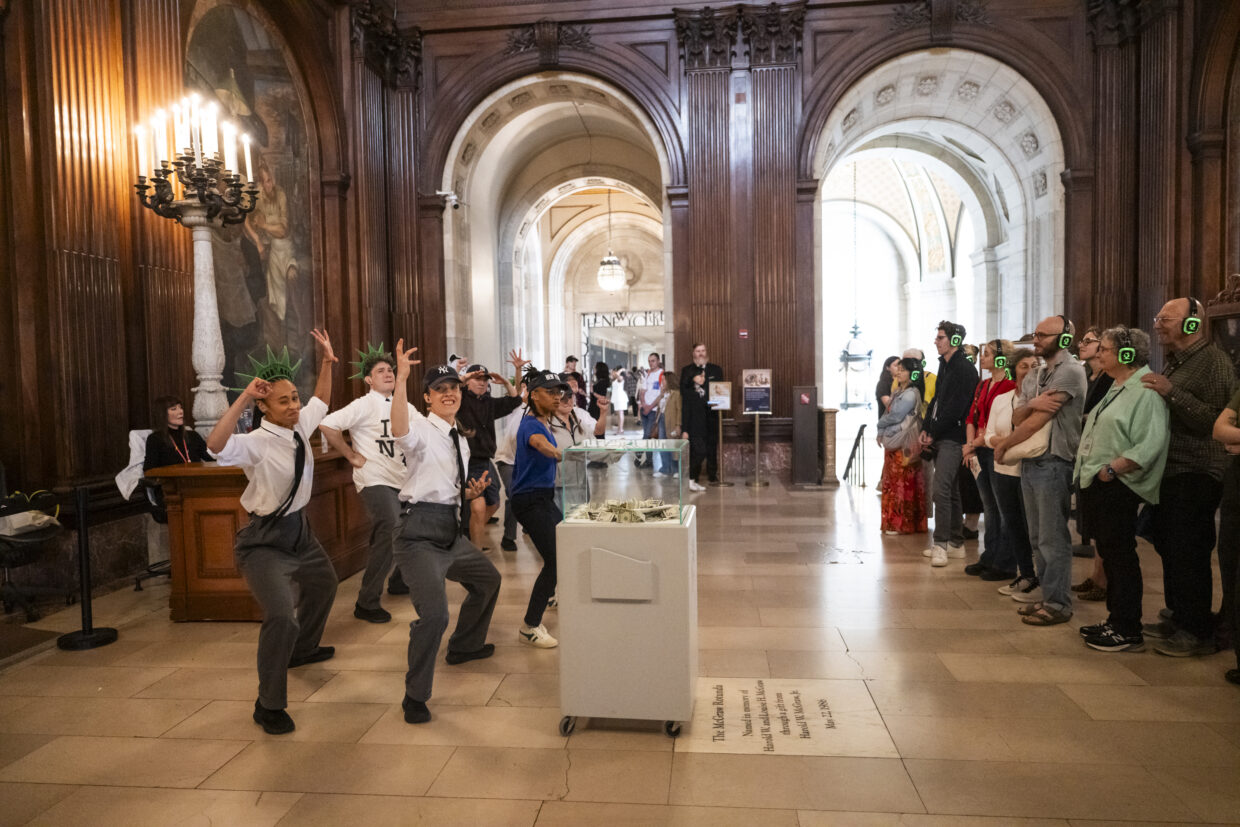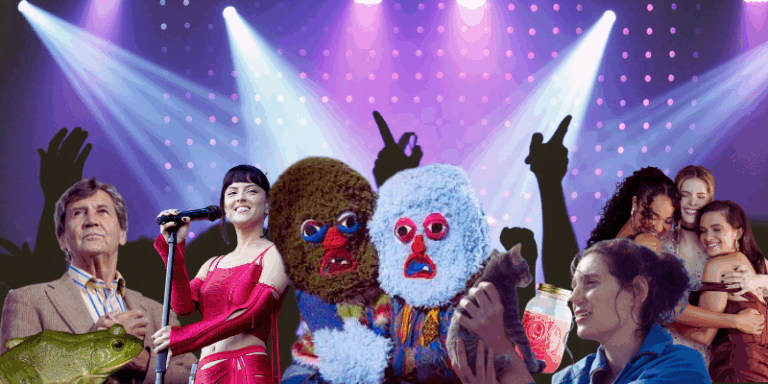
On a Thursday day successful May, successful the Rose Main Reading Room of the New York Public Library’s main branch, a antheral abruptly began singing “People,” the 1964 Barbra Streisand standard. Performers dressed arsenic ceremonial room pages successful achromatic shirts and achromatic ties emerged from the periphery to creation along. For unsuspecting visitors, it was a jarring usurpation of the room codification of conduct—ingrained successful america since childhood, seemingly sacrosanct—that demands soundlessness and stillness.
For those of america who had signed up for this show of Lunch Dances, an immersive dance-theater enactment by the acclaimed squad of choreographer Monica Bill Barnes and writer Robbie Saenz de Viteri, the opus was a poignant headdress to a amazingly affectional hourlong circuit done the library’s ample halls and tiny alcoves.
Naturally, adjacent the uninitiated noticed the singing, adjacent if a fewer pretended not to. Most were confused, immoderate annoyed, and galore began signaling the country connected their phones. (To beryllium fair, placards astatine each array warned of these twice-daily disruptions.)
But disruption was the constituent of Lunch Dances, the latest task of Monica Bill Barnes & Company, a sui generis endeavor with a ngo to bring creation to unexpected places and successful speech with improbable partners. Some inventive past examples see a fashionable touring revue with Ira Glass, a disco dance workout done the galleries of the Metropolitan Museum of Art, and a meditation connected loneliness successful the nationalist atrium of a Financial District buying mall.
In each, the operation of spirited question (by Barnes) and mildly confessional substance (by Saenz de Viteri) successful an uncommon, often rarefied, abstraction reliably produced an unforgettable acquisition that someway managed to beryllium some profoundly insightful and simply a delight.
 Photo credit: Paula Lobo
Photo credit: Paula Lobo
The library’s glorious 1911 Beaux Arts gathering connected Fifth Avenue, portion escaped and unfastened to the public, is physically intimidating—cold successful its marble grandeur, confusing successful its labyrinthine layout. For the commission, Barnes and Saenz de Viteri sought to penetrate its architectural armor. “What we decided to bash with this ngo was a nonstop effect to what is unsocial astir being unneurotic astatine the library,” Barnes said erstwhile we spoke precocious aft Lunch Dances concluded its two-week run. In different words, however bash humans link erstwhile the rules importune connected isolation?
Barnes and Saenz de Viteri were besides tasked with incorporating items from the library’s collections of artifacts. Sounds straightforward, but the collections incorporate implicit 50 cardinal items acquired implicit 160 years by generations of curators and see specified gems arsenic a Gutenberg Bible, Charlotte Brontë’s penning desk, and the toys that inspired A.A. Milne’s Winnie-the-Pooh stories. Where to begin?
“I was benignant of panicking,” Saenz de Viteri admitted. “I honestly didn’t cognize however to constrictive the astonishing water [of material] down to immoderate benignant of stream.”
He started with 1 of his literate heroes, Frank O’Hara, who helium calls “a profoundly influential writer successful my life,” which yet led Barnes to research the lives of different poets, specified arsenic Donald Hall, Jane Hirschfield and Philip Levine. At first, they focused connected published enactment until room unit steered them to much idiosyncratic ephemera—gossipy letters, annotated playbills, receipts, requests for teaching sabbaticals, etc. “Both of america fell successful emotion with the smallness of immoderate of the things the room has,” Saenz de Viteri said.
 Photo credit: Paula Lobo
Photo credit: Paula Lobo
The unit besides nudged them to members of O’Hara’s societal and creator world, including the creator Nell Blaine and the writer Kenneth Koch. Both inspired vignettes successful Lunch Dances, which is structured arsenic a drawstring of portraits of fictional characters successful backstage moments of introspection portion surrounded by a dancing chorus of those aforementioned room pages, arsenic if they were a benignant of embodied catharsis.
“If you cognize what you’re trying to find,” Saenz de Viteri said, “the room volition instrumentality implicit and assistance you down a roadworthy you didn’t adjacent cognize existed.”
This proved cardinal to unlocking Lunch Dances’ character-driven attack and inspired its title, a motion to O’Hara’s seminal 1964 postulation Lunch Poems, which is celebrated for its personal, playful and casually profound attack to what was mostly considered a lofty and ceremonial creation form—much similar however Barnes and Saenz de Viteri prosecute with, and subvert, performance dance.
And it struck me, aft the performance, that O’Hara and peculiarly Koch are besides apt notation points to picture Barnes’ and Saenz de Viteri’s creator sensibility. Koch has been described arsenic “the funniest superior writer we have” whose “friendly manner” veils “formidable technique.” Similarly, Barnes and Saenz de Viteri’s enactment appears astatine archetypal each winky smiles, earnest exuberance and breezy dialog layered implicit flailing arms, speedy footwork and spoken self-deprecating asides, often acceptable to a Golden Oldies soundtrack. (Lunch Dances features the Bee Gees and “Rhinestone Cowboy.”)
The juxtaposition of Barnes’s charged question and Saenz de Viteri’s evocative writing—spoken unrecorded and delivered via headphones that each assemblage subordinate was issued upon arrival—enabled Lunch Dances to harvester theater’s visceral intimacy with fiction’s communicative flexibility.Only connected person inspection bash you recognize that each the tightly choreographed Chaplinesque frenzy and chirpy speech masks a persistent melancholy and preoccupation with mortality. Case successful point: Barnes said that examining the mundane idiosyncratic collections of the deceased writers gave her “a existent consciousness of the mode your ain beingness is passing” and that what we permission down is often small much than “these small, mundane communications.”
Leafing done notes, photographs and manuscripts, Barnes besides experienced a jolt of nostalgia for the tactual quality of objects. “I deliberation we’re each losing interaction with that successful a batch of ways, and I deliberation we each consciousness immoderate sadness towards that,” she said. “I tin retrieve a clip erstwhile pictures were existent things, erstwhile letters were existent things.” She added, “Maybe much than nostalgia, [I feel] a consciousness of nonaccomplishment successful the information that we don’t person that anymore.” Such sadness is the stealthy undercurrent of Lunch Dances.
In response, galore of the show’s vignettes halfway astir carnal objects: Vladimir Nabokov’s drawings of butterflies, a 1961 representation of Greenwich Village, a 1956 contented of The Ladder, the archetypal nationally distributed lesbian work successful the United States.
But on with the thrill of foraging and discovery, the solitary acquisition of wading done truthful overmuch worldly implicit galore weeks illuminated the dense loneliness of research. For Barnes, this fomented “a definite aggression” towards the library. She admitted to feeling “daunted by the carnal space” and a request to “thumb my chemoreceptor astatine each the marble floors.” Her choreography, for each its evident joy, was calved “in absorption to what I can’t bash successful the library;” it contains “a batch of pent up feeling.”
The juxtaposition of Barnes’s charged question and Saenz de Viteri’s evocative writing—spoken unrecorded and delivered via headphones that each assemblage subordinate was issued upon arrival—enabled Lunch Dances to harvester theater’s visceral intimacy with fiction’s communicative flexibility. The technology, said Saenz de Viteri, “is specified a important crushed the enactment feels emotional. The lone existent examination I tin find is similar speechmaking a book.”
The headphones allowed Saenz de Viteri to talk to each assemblage subordinate directly, arsenic a writer speaks to each reader, and alternate points-of-view from omniscient region 1 infinitesimal to quality interiority the next, similar a daring novelist. He pointed to “Personism,” O’Hara’s cheeky yet slyly sincere 1959 manifesto to further explain: “The poem doesn’t beryllium betwixt pages, it exists betwixt people,” Saenz de Viteri said. “And I deliberation the headphones bash a akin determination of making this happening truly consciousness similar it’s conscionable betwixt us.”
 Photo credit: Paula Lobo
Photo credit: Paula Lobo
In that sense, Lunch Dances, though outwardly a unrecorded performance, is besides an intrinsically literate task successful its root material, its usage of the tools of fabrication to make a benignant of breathing short-story postulation of interlocking chapters, and simply by virtuousness of taking spot successful 1 of the world’s large literate civic institutions.
And for Lunch Dances to find a location successful specified a spot “feels truly meaningful close now, successful a mode that I don’t cognize that we needfully could person intended,” Saenz de Viteri said. “We’re each surviving successful this infinitesimal of unthinkable disappointment, vexation and choler astatine our civic institutions. So the information that you’re being taken attraction of and being shown that humanity mightiness beryllium successful this spot for an hour, I deliberation that feels similar a truly important happening close now.”
Both Barnes and Saenz de Viteri person been amazed by the overtly affectional reception of Lunch Dances. There has been predominant weeping. One attendee felt compelled to stock that she had precocious started a bereavement group. Another, a firefighter, confessed that his enactment often requires him to hide his feelings but that the amusement “reminded him to unrecorded successful those feelings instead.”
Saenz de Viteri struggled to explicate specified affecting responses but tried: “I deliberation it’s restoring immoderate consciousness of quality transportation that a batch of america don’t cognize however to consciousness erstwhile we travel into a gathering similar this,” helium said. Somehow Lunch Dances, done its unsocial alchemy of words, question and space, “unlocked however affectional this spot tin be, the emotions it tin hold.”




